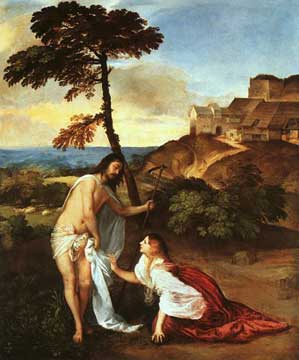
All the talk around the potential sale of two of the most important paintings in British collections (Titian’s Diana and Actaeon and Diana and Callisto) has generated more interest than usual in the public value of works of art, or the distinction, at least, between value and worth. That this debate is happening against the backdrop of crumbling financial institutions on the one hand and astronomical flashing of cash on the other makes the discussion all the more important now, underscoring the need for patient re-evaluation of art and its importance to the wider world.
With that in mind, a smaller Titian painting in the National Gallery, Noli me Tangere, has been drawing me back more and more in recent months. Titian was about 19 when he painted this; it’s small enough to be intended for private worship, and to be drowned out in proximity to larger and more celebrated Titians in its room (like this one). Against a backdrop of tumbling hills, farm buildings, scattered sheep and a rich melancholy Venetian sunset, Mary Magdalene reaches towards the recently-resurrected Christ. She’s just realized who he is and what’s happened, and tries to touch him; he bends away (his bent body, like an open parenthesis, imitated by the bend of the tree above), to demonstrate the need to focus on the spiritual rather than earthly, the soul and not the body. What seems to happen is that shape–a curve leaning away from a vertical, like a sprung bow–echoes across the shapes of the painting, like a chorus.
As a meditation on the nature of mortality, the painting is exemplary and that poignancy opened up its second life, during World War II, when the Blitz was ravaging the city (there are still ragged craters—bomb damage—on the sides of Tate Britain and the Victoria and Albert Museum). The National Gallery’s emergency plan was to ship its paintings to the Welsh countryside (contingency plans like this had been actioned by all the major institutions: the Parthenon Frieze spent most of the forties in the dank gloom of a disused tunnel in Aldwych tube station), where they sat in slate mines, gradually brought back one by one to the gallery. The first to return was Noli me Tangere, due to vociferous pressure from the public documented in newspapers of the time. A letter written to the London Times in January 1942 explained, “Because London’s face is scarred and bruised these days, we need more than ever to see beautiful things.”
So for the first month–with the exception of a small display of contemporary paintings–Noli me Tangere was the only painting in the National Gallery. For Londoners under constant threat of extinction from above, this small High Renaissance painting, produced as a display of virtuosity and ingenuity by a young artist on the make in the aristocratic circles of early 16th century Venice, contained an idea of transcendence that collapsed historical time and lived again at that moment. It might be worth reminding ourselves, especially now, that that’s what art is supposed to do.